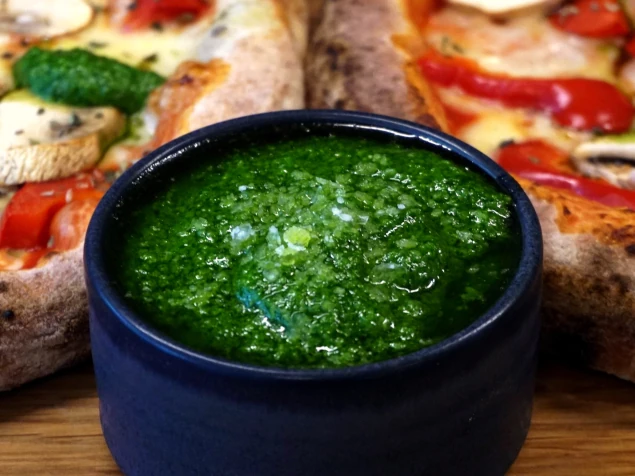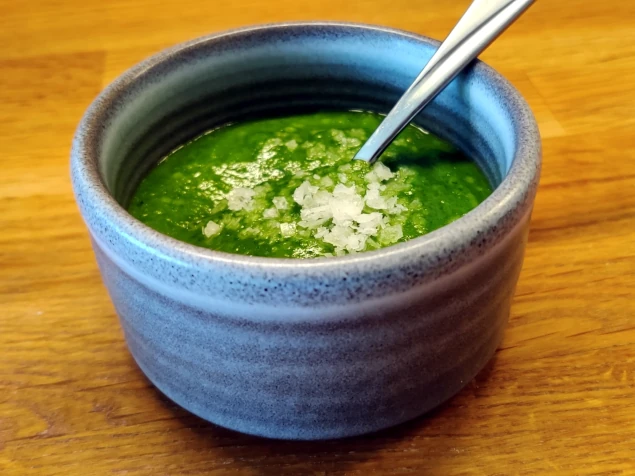Wild Garlic Pesto
Creamy pesto with wild garlic


- Servings8 Portions
- AllergensMilk
- Cook Time15 min
As soon as I get the opportunity to get wild garlic (also known as known as wild cowleek, ramsons, buckrams, broad-leaved garlic, wood garlic, bear leek or bears garlic) I will rush to the forest and the backpack will be filled with as much as it is possible to carry. I really love ramsons and pesto is just one of the things I do with them - I usually freeze some and pick out for some soups and the like, but pesto is a must. Remember that ramsons must not be picked in nature reserves! Ramsons can also be mistaken for e.g. lily of the valley which is poisonous so do not pick in nature unless you know for sure the difference.
Ramsoms are fairly rare and are protected in parts of Sweden, but it is not endangered. It is one of Swedens first spring primaries and in southern Skåne they can appear as early as February, but it is more common to start seeing them in March and April. You can recognize ramsons on their shiny green leaves, open snow-white flowers and the strong scent of onions. In the places where I have picked them, you feel a very strong onion scent (garlic) that spreads throughout the area where they often grow in large beautiful fields, especially when the leaves begin to wither. Ramsoms bloom in May-June with pure white flowers. It is commonly used in cooking such as. Germany where it is used as a herb but in recent years the ramsons have regained their popularity in more places where it is found in nature. I have been picking ramsoms until July, but the early spreading leaves are the most delicious. Unlike other onion plants, it is the leaves you use and not the onion itself.
There have been some studies on ramsons and they have concluded that it is considered a natural antibiotic. A water-based extract of ramsons has a strong antibacterial effect. Areas of use are, for example, cure colds, counteract blood clots and prevent atherosclerosis.
In this recipe I use Grana Padano, but a well-aged cheese also works. I have also replaced the more classic pesto ingredient pine nuts with cashews because I think it tastes similar but is significantly cheaper. Pine nuts are insanely good and should be enjoyed roasted for themselves or whole as a topping on e.g. salads.
The measurements are as usual in grams, but 50 grams is almost 50 leaves, so make sure you have a good load with you home from the forest. It makes it easier to have a smaller mixer for this - too large a mixer can have problems mixing everything evenly. Should you not have enough wild garlic in relation to the other ingredients, use a handful of basil to fill.
Ingredients
Nutrition Facts*
| Total | Serving | 100 g | |
|---|---|---|---|
| Energy | 1262.86 kcal | 157.86 kcal | 542 kcal |
| Carbohydrates | 18.01 g | 2.25 g | 7.73 g |
| Fat | 127.03 g | 15.88 g | 54.52 g |
| Protein | 18.15 g | 2.27 g | 7.79 g |
| Sugar | 1.19 g | 0.15 g | 0.51 g |
| Salt | 3.47 g | 0.43 g | 1.49 g |
* The nutritional information provided is approximate and is calculated using the ingredients available in the database. Info will vary based on cooking methods and brands of ingredients used.
Directions
- Clean and chop the wild garlic.
- Add all the ingredients to a small blender. Mix until the pesto is smooth.
- Add salt and possibly pepper to taste.
- Enjoy pesto as a pasta sauce or use as a seasoning for chicken, salmon or grilled vegetables.
- It is also excellent for spreading on bread such as focaccia.